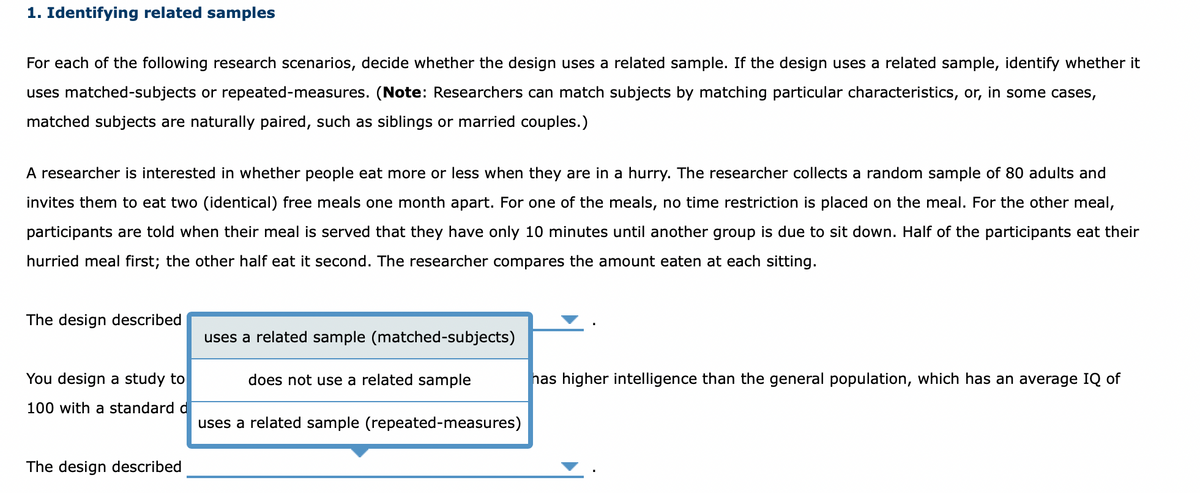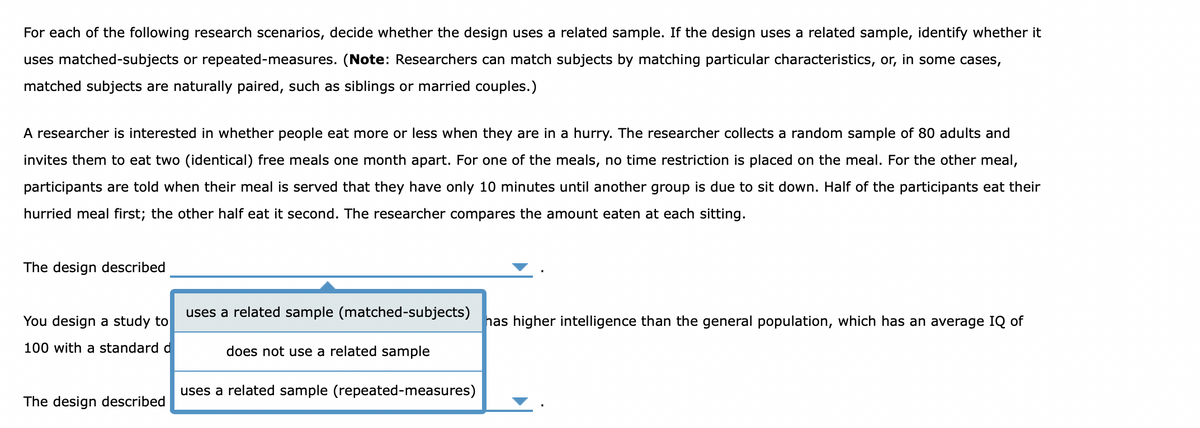1. Identifying related samples For each of the following research scenarios, decide whether the design uses a related sample. If the design uses a related sample, identify whether it uses matched-subjects or repeated-measures. (Note: Researchers can match subjects by matching particular characteristics, or, in some cases, matched subjects are naturally paired, such as siblings or married couples.) A researcher is interested in whether people eat more or less when they are in a hurry. The researcher collects a random sample of 80 adults and invites them to eat two (identical) free meals one month apart. For one of the meals, no time restriction is placed on the meal. For the other meal, participants are told when their meal is served that they have only 10 minutes until another group is due to sit down. Half of the participants eat their hurried meal first; the other half eat it second. The researcher compares the amount eaten at each sitting. The design described uses a related sample (matched-subjects) You design a study to does not use a related sample has higher intelligence than the general population, which has an average IQ of 100 with a standard d uses a related sample (repeated-measures) The design described
1. Identifying related samples For each of the following research scenarios, decide whether the design uses a related sample. If the design uses a related sample, identify whether it uses matched-subjects or repeated-measures. (Note: Researchers can match subjects by matching particular characteristics, or, in some cases, matched subjects are naturally paired, such as siblings or married couples.) A researcher is interested in whether people eat more or less when they are in a hurry. The researcher collects a random sample of 80 adults and invites them to eat two (identical) free meals one month apart. For one of the meals, no time restriction is placed on the meal. For the other meal, participants are told when their meal is served that they have only 10 minutes until another group is due to sit down. Half of the participants eat their hurried meal first; the other half eat it second. The researcher compares the amount eaten at each sitting. The design described uses a related sample (matched-subjects) You design a study to does not use a related sample has higher intelligence than the general population, which has an average IQ of 100 with a standard d uses a related sample (repeated-measures) The design described
Glencoe Algebra 1, Student Edition, 9780079039897, 0079039898, 2018
18th Edition
ISBN:9780079039897
Author:Carter
Publisher:Carter
Chapter4: Equations Of Linear Functions
Section: Chapter Questions
Problem 8SGR
Related questions
Question

Transcribed Image Text:1. Identifying related samples
For each of the following research scenarios, decide whether the design uses a related sample. If the design uses a related sample, identify whether it
uses matched-subjects or repeated-measures. (Note: Researchers can match subjects by matching particular characteristics, or, in some cases,
matched subjects are naturally paired, such as siblings or married couples.)
A researcher is interested in whether people eat more or less when they are in a hurry. The researcher collects a random sample of 80 adults and
invites them to eat two (identical) free meals one month apart. For one of the meals, no time restriction is placed on the meal. For the other meal,
participants are told when their meal is served that they have only 10 minutes until another group is due to sit down. Half of the participants eat their
hurried meal first; the other half eat it second. The researcher compares the amount eaten at each sitting.
The design described
uses a related sample (matched-subjects)
You design a study to
does not use a related sample
has higher intelligence than the general population, which has an average IQ of
100 with a standard d
uses a related sample (repeated-measures)
The design described

Transcribed Image Text:For each of the following research scenarios, decide whether the design uses a related sample. If the design uses a related sample, identify whether it
uses matched-subjects or repeated-measures. (Note: Researchers can match subjects by matching particular characteristics, or, in some cases,
matched subjects are naturally paired, such as siblings or married couples.)
A researcher is interested in whether people eat more or less when they are in a hurry. The researcher collects a random sample of 80 adults and
invites them to eat two (identical) free meals one month apart. For one of the meals, no time restriction is placed on the meal. For the other meal,
participants are told when their meal is served that they have only 10 minutes until another group is due to sit down. Half of the participants eat their
hurried meal first; the other half eat it second. The researcher compares the amount eaten at each sitting.
The design described
uses a related sample (matched-subjects)
You design a study to
has higher intelligence than the general population, which has an average IQ of
100 with a standard d
does not use a related sample
uses a related sample (repeated-measures)
The design described
Expert Solution
This question has been solved!
Explore an expertly crafted, step-by-step solution for a thorough understanding of key concepts.
This is a popular solution!
Trending now
This is a popular solution!
Step by step
Solved in 2 steps

Recommended textbooks for you

Glencoe Algebra 1, Student Edition, 9780079039897…
Algebra
ISBN:
9780079039897
Author:
Carter
Publisher:
McGraw Hill

College Algebra (MindTap Course List)
Algebra
ISBN:
9781305652231
Author:
R. David Gustafson, Jeff Hughes
Publisher:
Cengage Learning

Glencoe Algebra 1, Student Edition, 9780079039897…
Algebra
ISBN:
9780079039897
Author:
Carter
Publisher:
McGraw Hill

College Algebra (MindTap Course List)
Algebra
ISBN:
9781305652231
Author:
R. David Gustafson, Jeff Hughes
Publisher:
Cengage Learning